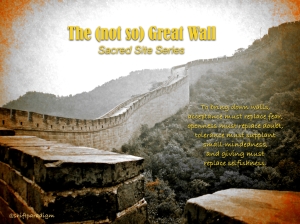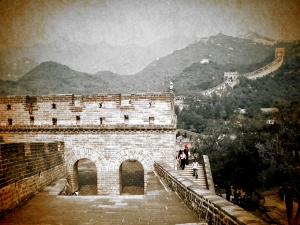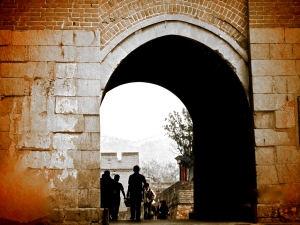Since the earliest times, people have ascribed sacred significance to certain places. Such places—whether human made or naturally occurring—typically inspire awe, and often invoke devotion and respect. Not surprisingly many of these places are revered and well known. There are some places, however, that are less known, even hidden. They await discovery. Here I pay homage to a place that has sacred meaning for me.
 I stand atop a flat stone. My feet and legs feel the coldness it radiates. My eyes see that it connects to other equally cold stones. They in turn connect to stones, on and on to make a Great Wall. An expanse—30 feet wide, 25 feet tall, and 13,171-miles long—that coldly splits mountains, plains, and desert. Forming the northern boundary of what was once ancient China.
I stand atop a flat stone. My feet and legs feel the coldness it radiates. My eyes see that it connects to other equally cold stones. They in turn connect to stones, on and on to make a Great Wall. An expanse—30 feet wide, 25 feet tall, and 13,171-miles long—that coldly splits mountains, plains, and desert. Forming the northern boundary of what was once ancient China.
I think about the Emperors who wanted the wall. The cold, distant manner in which they treated the millions of laborers—soldiers, peasants, and prisoners—who built the wall. How the backs of the laborers must have ached from the tons of bricks, rocks, sand, and dirt they had to carry. That using the simple tools of the time to process these materials would have pained their calloused hands. The way the sweat, blood, and flesh of the laborers bind everything together here. Making each inch and every ounce of the wall a cold, somber, and unspoken tribute to them.
My perseveration on the building of the wall abruptly stops when history grabs my mind. Forcing me to ponder the long forgotten merchants, priests, families, and Silk Road travellers who once stood where I now stand. The countless lives lived and lost here. Empires and eras the wall has shaped. Trade and communication it enabled. Battles fought and deals made on these very stones. How the cold, inert, and unfeeling wall has for over 2300 years affected these things and more.
 The west side of the wall pulls me to it. Struggling to keep my fear of heights in check, I nauseously peer over the edge at its steepness. The smooth stone-on-stone patina of the west wall, has no cracks or crevasses into which a finger or toe might fit. Leaving no way for scaling it. Too thick and too hard, there is no way to bore through it. Sending a cold, uncaring message to people outside of the wall—GO AWAY!
The west side of the wall pulls me to it. Struggling to keep my fear of heights in check, I nauseously peer over the edge at its steepness. The smooth stone-on-stone patina of the west wall, has no cracks or crevasses into which a finger or toe might fit. Leaving no way for scaling it. Too thick and too hard, there is no way to bore through it. Sending a cold, uncaring message to people outside of the wall—GO AWAY!
On the east side of the wall, I look at its steep and impenetrable capacity for keeping people inside. Coldly insulating them from outside influences and opportunities. Curtailing their mobility. Encouraging collectivity. Quelling rebellion. Stifling creativity. The inside wall is constant reminder to people living here to maintain the status quo.
Walking along the top of the wall, I think about all the energy and resources it has taken to maintain this massive structure for all these years. The constant diligence and never ending attention to detail that doing so requires. How for the wall to fulfill its obligation of keeping people out and in, there must be no softening. For a warming of resolve at one point compromises the integrity of the entire wall.
A gate is the only way to get from one side to the other of an uncompromised wall. Heavily fortified and carefully guarded, gates are located at predictable intervals along the wall. A gate on one side is opposite a gate on the other side, a passageway between them.
 People wanting to pass through the wall must first go through one gate. Then pause in the passageway while the gate they just came through is closed. And finally when the gate on the other side opens, they go through it. Passage is not free. Nor, as the tedious steps, tolls, taxes, or tariffs make clear, are the people passing through the gates.
People wanting to pass through the wall must first go through one gate. Then pause in the passageway while the gate they just came through is closed. And finally when the gate on the other side opens, they go through it. Passage is not free. Nor, as the tedious steps, tolls, taxes, or tariffs make clear, are the people passing through the gates.
The passageways between most gates have a stairs leading top of the wall. The stone atop the wall on which I have been standing, is near one such stairs. I walk down it to a passageway. Then go out a gate.
Walking away, I think about my life and the walls I erect. How some walls I erect keep me safe, mitigate risk, and preserve health. These I construct from experience and knowledge. They set boundaries of behavior—moderation in food and drink, balance between work and play, acceptable places and relationships to enter, and so on. These walls rest atop a foundation of prudence.
I erect other walls to repel, curtail, and control people with whom I do not want to engage. Many of them are different than me. Others challenge my thinking. Some question my authority. I build these walls with my actions, thoughts, and beliefs. They, like the Great Wall on which I recently stood, tell people to GO AWAY. Emotions and values are the foundation on which such walls rest.
Some walls I erect to prevent people from seeing my true nature. They hide my vulnerabilities, mask my intentions, and help me avoid responsibility. Sublimated needs, kept secrets, and repressed feelings are the building blocks for these walls. Selfishness is the foundation on which I build them.
Continuing to walk, I think about how fears, doubts, and insecurities led me to erect each type of wall. How fear of injury, taking risks, and getting sick prompted me to erect walls of safety. That doubts of being good enough or different compelled me to erect walls that kept people out. And the way my insecurities became a justification for not giving voice to my needs and intentions.
Stopping to look back at the Great Wall one last time, I see the way it coldly splits the countryside. How it enables people on one side to not deal with those on the other side. I think about the walls I erect, how they enable me to avoid dealing with issues within myself. That when confronted by an issue, rather than deal with it then and there I erect a wall.
It has been seven years since I stood atop the Great Wall. I have done my best to apply the lesson I learned there to my life. To see the walls I erect or encounter. Consider why each is there. Call it by its true name. Refuse to maintain it. Let it crumble and fade away.
Mastering this lesson has brought me face-to-face with the cold, hard truth about my walls. They do not curtail people and issues, they curtail me. To bring down walls, acceptance must replace fear, openness must replace doubt, tolerance must supplant small-mindedness, and giving must replace selfishness. Amidst the present day talk of erecting more and bigger walls, I choose to be accepting, open, tolerant, and giving. What do you choose?
Mark
Note: This is the fourth post in the Sacred Places series. Please click the subscribe button on the right side of the blog page to be notified of future posts.

You must be logged in to post a comment.